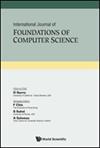Quantum and Approximation Algorithms for Maximum Witnesses of Boolean Matrix Products
IF 0.6
4区 计算机科学
Q4 COMPUTER SCIENCE, THEORY & METHODS
International Journal of Foundations of Computer Science
Pub Date : 2023-11-10
DOI:10.1142/s0129054123500259
引用次数: 1
Abstract
The problem of finding maximum (or minimum) witnesses of the Boolean product of two Boolean matrices (MW for short) has a number of important applications, in particular the all-pairs lowest common ancestor (LCA) problem in directed acyclic graphs (dags). The best known upper time-bound on the MW problem for [Formula: see text] Boolean matrices of the form [Formula: see text] has not been substantially improved since 2006. In order to obtain faster algorithms for this problem, we study quantum algorithms for MW and approximation algorithms for MW (in the classical computational model). Some of our quantum algorithms are input or output sensitive. Our fastest quantum algorithm for the MW problem, and consequently for the related problems, runs in time [Formula: see text], where [Formula: see text] satisfies the equation [Formula: see text] and [Formula: see text] is the exponent of the multiplication of an [Formula: see text] matrix by an [Formula: see text] matrix. Next, we consider a relaxed version of the MW problem (in the classical model) asking for reporting a witness of bounded rank (the maximum witness has rank 1) for each non-zero entry of the matrix product. First, by adapting the fastest known algorithm for maximum witnesses, we obtain an algorithm for the relaxed problem that reports for each non-zero entry of the product matrix a witness of rank at most [Formula: see text] in time [Formula: see text] Then, by reducing the relaxed problem to the so called [Formula: see text]-witness problem, we provide an algorithm that reports for each non-zero entry [Formula: see text] of the product matrix [Formula: see text] a witness of rank [Formula: see text], where [Formula: see text] is the number of witnesses for [Formula: see text], with high probability. The algorithm runs in [Formula: see text] time, where [Formula: see text].布尔矩阵乘积最大见证的量子和近似算法
寻找两个布尔矩阵的布尔积的最大(或最小)见证人的问题有许多重要的应用,特别是有向无环图(dag)中的全对最低共同祖先(LCA)问题。对于形式为[公式:见文本]的布尔矩阵,最著名的MW问题的上时限自2006年以来没有得到实质性的改进。为了得到求解这一问题的更快的算法,我们研究了量子算法和近似算法(在经典计算模型中)。我们的一些量子算法是输入或输出敏感的。对于MW问题,我们最快的量子算法,因此对于相关问题,在时间内运行[公式:见文],其中[公式:见文]满足方程[公式:见文],[公式:见文]是一个[公式:见文]矩阵乘以一个[公式:见文]矩阵的指数。接下来,我们考虑一个放宽版本的MW问题(在经典模型中),要求为矩阵乘积的每个非零条目报告一个有界秩的见证人(最大见证人的秩为1)。首先,通过适应已知最快的算法最大的目击者,我们获得放松的一个算法的问题,报告的每个非零项产品矩阵秩的见证(公式:看到文本)大部分时间(公式:看到文本),通过减少所谓的放松限制问题(公式:看到文本)问题,譬如我们提供一个算法报告每个非零项(公式:看到文本)的产品矩阵(公式:看到文本)证人的等级(公式:见文],其中[公式:见文]是[公式:见文]的证人人数,具有高概率。算法运行时间为[公式:见文],其中[公式:见文]。
本文章由计算机程序翻译,如有差异,请以英文原文为准。
求助全文
约1分钟内获得全文
求助全文
来源期刊

International Journal of Foundations of Computer Science
工程技术-计算机:理论方法
CiteScore
1.60
自引率
12.50%
发文量
63
审稿时长
3 months
期刊介绍:
The International Journal of Foundations of Computer Science is a bimonthly journal that publishes articles which contribute new theoretical results in all areas of the foundations of computer science. The theoretical and mathematical aspects covered include:
- Algebraic theory of computing and formal systems
- Algorithm and system implementation issues
- Approximation, probabilistic, and randomized algorithms
- Automata and formal languages
- Automated deduction
- Combinatorics and graph theory
- Complexity theory
- Computational biology and bioinformatics
- Cryptography
- Database theory
- Data structures
- Design and analysis of algorithms
- DNA computing
- Foundations of computer security
- Foundations of high-performance computing
 求助内容:
求助内容: 应助结果提醒方式:
应助结果提醒方式:


